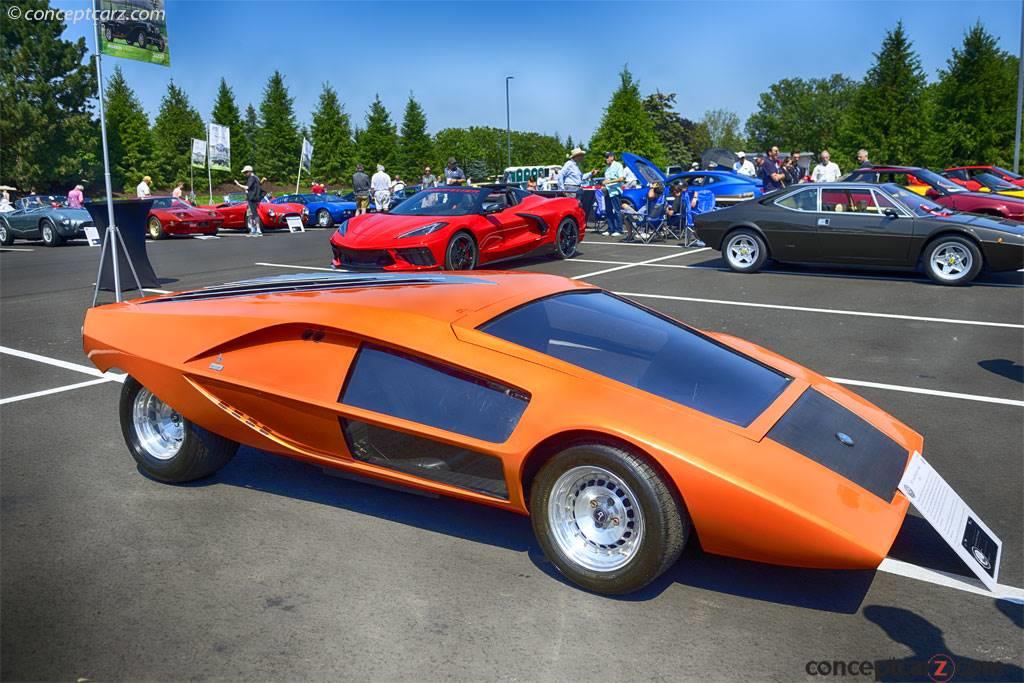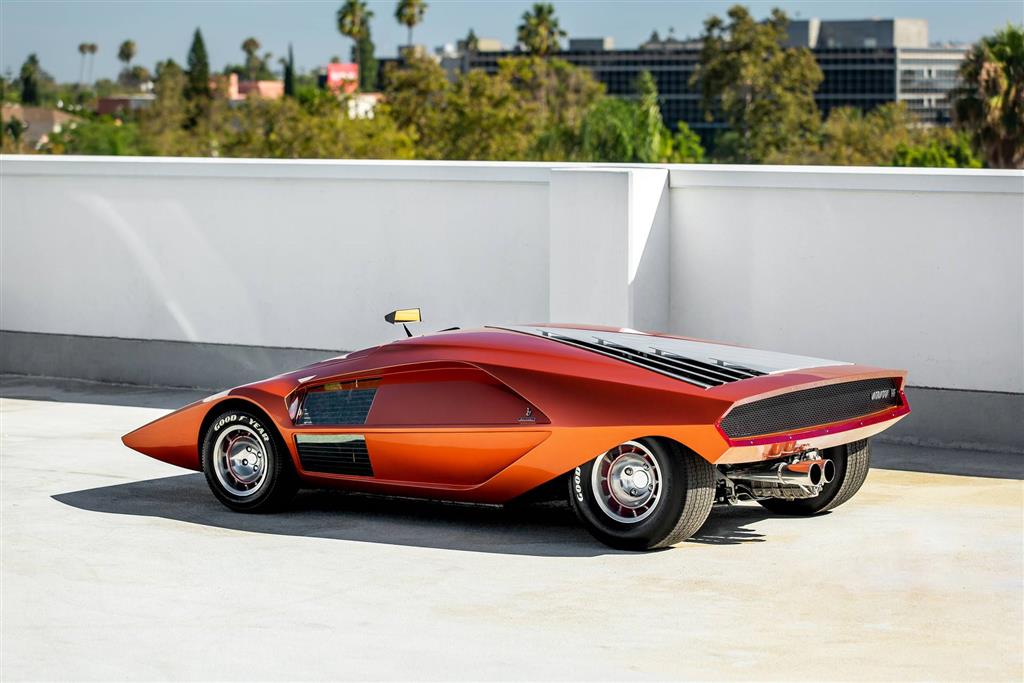Bertone's experimentation with the futuristic 'wedge-shaped' design percolated with the one-off Lamborghini Marzal concept of 1967 and the Alfa Romeo Carabo Concept of 1968. Both wore styling by Marcello Gandini of Bertone design studio and would be catalysts for a great design rivalry that would erupt between Bertone and Pininfarina during the turn of the 1970s. Italdesign would join the fray with the Bizzarrini Mantra and the Alfa Romeo Iguana, both wearing interpretations of the sharp-angled, wedge-shaped design. Pininfarina's response wore smoother and curvaceous lines applied to the Ferrari P5, the 512S Berlinetta, and the Modulo. 
Coupe by Bertone
Chassis #: C/1160
View info and history
Auction entries : 1The car that appeared on Bertone's stand at the Turin Motor Show in 1970 was dubbed the 'Stratos HF,' although Bertone had championed the name 'Stratolimite,' as in 'limit of the stratosphere.' It later became known simply by its internal nickname of 'Zero.' The chiseled shape of Stratos Zero was a bold design statement, an evolution of the 1968 Carabo, and a foreshadowing of future designs applied to the Countach prototype of 1971. Design elements included a front headlight strip backlit by ten 55W bulbs at the front, while the rear strip used no less than 84 tiny bulbs spread all around the perimeter of the truncated tail. The turn signals used the same lights that lit up in succession from the center to the edges. The full-width row of ultrathin headlights was echoed by the ribbon rear taillights surrounding a mesh grille. Dual exhausts were offset to the side of the protruding gearbox case and flanked on either side by wide tires. The wheel fairings that hugged the narrow cabin provided just enough space to accommodate short McPherson struts. The engine cover was an aesthetically pleasing triangular shape with slats shaped to direct air toward the radiator, which was placed all the way to the rear of the engine bay. The interior cabin, positioned far forward and over the front wheels, was accessed by way of a flip-up windscreen. A sourced hydraulic linkage allowed the steering column to be pushed forward, allowing access to the driver's seat, when the windscreen would lift. A black rectangle at the bottom of the windscreen was a small rubber step plate intended to make entry and exit easier. The Lancia Stratos Zeo received mechanical components from the Lancia parts bin, including the mid-mounted 1.6-liter Lancia V-4 engine of the Fulvia HF. The sub-chassis and suspension (including the double-wishbones with transverse leaf spring arrangement) were from a Fulvia Coupe that had been involved in an accident, unbeknownst to Lancia. Disc brakes at all four corners provided the stopping power. On the right side of the engine bay was a 45-liter fuel tank and twin fans assisted radiator cooling. 
Coupe by Bertone
Chassis #: 820031002333
View info and history
Auction entries : 1The interior could accommodate two individuals who sat as horizontal and as close to the ground as possible. The seats had a 'chocolate bar' pattern that would later be used on the Lamborghini Countach LP500. The top side windows slid backward into the bodywork. A futuristic instrument panel was offset to the side behind the front wheel arch and had graphics hand-etched in the green Perspex. The steering wheel was made by Italian manufacturer Gallino-Hellebore. The rear-view mirrors were located inside the side scallops providing adequate but limited rear vision. During road tests, a small overhead mirror was occasionally installed. A 'pop-up' wiper was concealed underneath a trap door at the base of the windscreen. Despite the minimalistic interior accommodations for two occupants, design engineers managed to pen space for a spare wheel and luggage right behind the driver. In an interview with Giancarlo Perini in 1977, Marcello Gandini remarked: 'The very first Stratos was designed as freely as the Autobianchi Runabout and reached the aim for which it was intended: to establish a bridge between Lancia and Bertone. Having established the bridge, Lancia asked us to come up with an idea for a new sports car that would go rallying in the world championships.'
Coupe by Bertone
Chassis #: C/1160
View info and history
Auction entries : 1In 2000, the Stratos Zero received a full restoration in-house at Stile Bertone in Caprie. During the process, the car regained its original bronze livery, which replaced the silver finish it had received after its initial presentation.
by Daniel Vaughan | Aug 2021

Coupe by Bertone
Chassis #: C/1160
View info and history
Auction entries : 1

Coupe by Bertone
Chassis #: 820031002333
View info and history
Auction entries : 1

Coupe by Bertone
Chassis #: C/1160
View info and history
Auction entries : 1
by Daniel Vaughan | Aug 2021
In terms of car design, the most original idea to come out of 1970 was a futuristic prototype by the name of Stratos 0, fruit of Bertone inspiration. It all started with the idea of mounting the engine block from a Lancia Fulvia 1.6 HF on a new base. The engine was centrally mounted in a lowered position, and the suspensions and steering elements were designed according to a revolutionary line, breaking out of any known set moulds. The result is a flowing shape that tapers in sharply at both ends, 358 cm long and just 84 cm high. The presence of the four wheels is the only conceptual link to the contemporary idea of an automobile. The marked shaping of the wings, which accentuate the wedge-shape of the body, and the triangular motif of the roof, and air vents, all serve to underline its stylistic divide from the classic elements of car design. The technical features employed are astounding: the double side windows, the front and rear lights, and the access to the car with the entire front of the vehicle opening up to let the driver literally walk up to the driving seat. The 'Stratoline,' as Nuccio Bertone had initially christened it, goes beyond an exercise in design to represent a global reworking of the actual concept of what makes a car.Source - Bertone
Related Reading : Lancia Stratos History
A big success by any standard both in and out of competition, the Lancia Stratos was developed as a homologation Special for European rallying. After production ceased, it became a cult car and is now highly-priced as the modern classis it is. Conceived strictly for rallying, the Lancia Stratos, however, makes an exciting road car, though it is very far from GT standards in both luxury and refinement. The....
Continue Reading >>
Continue Reading >>
Lancia
Similar Vehicles
1970 Lancia Stratos Zero Vehicle Profiles
Recent Vehicle Additions
Related Automotive News

1984 Honda HP-X Concept Car Makes North American Debut at 2024 Pebble Beach Concours d'Elegance
Following an extensive restoration, the HP-X Concept will be entered in the Wedge-Shaped Concept Cars and PrototypesClass at the Pebble Beach Concours
Honda HP-X Concept originally debuted at the 1984 Turin Auto Show, signaling the companys int...

Lamborghini Celebrates The 50Th Anniversary Of The Jarama GT
This year marks the 50th Anniversary of the Lamborghini Jarama GT, presented for the first time at the Geneva Motor Show in March 1970.
The Jarama, whose name derives from an area north of Madrid famous for breeding fighting bulls, was the latest evolution...

Lamborghini Miura Celebrated In A Dedicated Class At The 59Th Pebble Beach Concours d'Elegance
SantAgata Bolognese, 12 August 2019 – The Pebble Beach Concours dElegance, established in 1950, is the one of the most renowned classic car shows in the world, and every year the selection of cars for display is very severe, because only the...

Maserati At The 2018 Auto e Moto d’Epoca Show In Padua
Three iconic cars on display on the Maserati stand
Tipo 420M-58 – Eldorado, Merak SS and Khamsin
The Brands current range represented by the Maserati Levante S GranSport MY19
Modena, 25 October 2018 - Maserati is exhibiting at the Auto e...

Seven Iconic Cars To Celebrate 70 Years Of Maserati GT Models As My18 Maserati Granturismo And Grancabrio Arrive In UK
Restyled MY18 GranTurismo and GranCabrio are now available in the UK
GranTurismo starts at £94,285 OTR, while GranCabrio is priced from£108,340 OTR
Maserati celebrates 70 years of GranTurismo, with seven iconic images from seven decades of GT
...







































